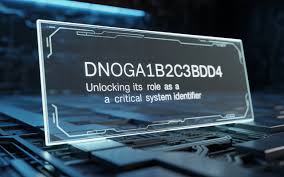What Is Dnoga1b2c3d4?
Dnoga1b2c3d4 is a concept that has garnered significant attention in various fields due to its unique properties and applications. At its core, dnoga1b2c3d4 refers to a specific framework or model used to explore and analyze complex systems. The term originates from a blend of scientific and technological influences, often rooted in mathematics and theoretical physics. Its formation lies in the need to create a structured approach for understanding intricate processes that might otherwise seem chaotic.
The context in which dnoga1b2c3d4 operates is multifaceted. It encompasses an array of disciplines, including computer science, engineering, and even social sciences, thereby highlighting its versatility. By providing a common language and methodology, dnoga1b2c3d4 serves as a bridge that connects disparate fields of study. Researchers and practitioners leverage this framework to study relationships, patterns, and trends within their respective domains, ultimately leading to more informed decision-making and innovation.
The fundamental characteristics of dnoga1b2c3d4 are what make it particularly notable. Crucially, it allows for the modeling of variables and scenarios that exhibit nonlinear behaviors, which are often challenging to quantify. This characteristic is essential for capturing the dynamics of real-world systems that can fluctuate unpredictably. Furthermore, dnoga1b2c3d4 emphasizes the importance of data-driven insights, encouraging practitioners to rely on empirical evidence while constructing their analyses.
Overall, understanding the definition and framework of dnoga1b2c3d4 is crucial for navigating the complexities of its applications. This foundational perspective sets the stage for a more in-depth exploration of dnoga1b2c3d4’s implications and the transformative impact it can hold across various sectors.
Applications and Use Cases of Dnoga1b2c3d4
The term dnoga1b2c3d4 has gained traction across various industries due to its adaptable nature and practical applications. Among the most notable fields utilizing dnoga1b2c3d4 is the technology sector. Here, it serves as a backbone for developing software solutions that enhance data processing capabilities and streamline workflow management. For instance, companies have harnessed the potential of dnoga1b2c3d4 to improve project tracking and increase efficiency in software development life cycles.
In the realm of healthcare, dnoga1b2c3d4 is proving to be invaluable. Healthcare providers utilize this framework to manage patient data meticulously, ensuring compliance with privacy regulations while optimizing treatment workflows. Hospitals implementing dnoga1b2c3d4 systems have reported reduced administrative burdens, allowing healthcare professionals to concentrate on patient care rather than paperwork.
Additionally, the manufacturing industry is reaping the benefits of dnoga1b2c3d4 through enhanced supply chain management. Businesses that integrate dnoga1b2c3d4 methodologies can track inventory levels in real time, leading to significant reductions in waste and increased production efficiency. A case study from a prominent automobile manufacturer revealed that by adopting dnoga1b2c3d4 principles, they successfully minimized delays in their production line and optimized resource allocation.
The education sector is also beginning to embrace dnoga1b2c3d4, offering online learning platforms that support interactive learning experiences. Schools and universities leveraging dnoga1b2c3d4 systems are able to personalize educational content to meet individual student needs, significantly improving engagement and comprehension levels.
In summary, dnoga1b2c3d4’s versatility lends itself to a multitude of applications across various fields, demonstrating its transformative potential. Real-world examples and case studies highlight the framework’s effectiveness in enhancing processes and efficiency, making it a key component in modern industry practices.

Challenges and Considerations in Implementing Dnoga1b2c3d4
The implementation of dnoga1b2c3d4 comes with a range of challenges and considerations that stakeholders must navigate to ensure a successful integration. One significant barrier is the technological aspect, as existing systems may require substantial upgrades or overhauls to accommodate the new framework. Compatibility issues can arise, potentially leading to operational disruptions. Therefore, organizations must evaluate their current technological infrastructure and identify potential gaps that could impede the implementation process.
Another critical consideration is the cost associated with implementing dnoga1b2c3d4. The financial investment needed for software, hardware, and training can be substantial. Stakeholders must conduct a thorough cost-benefit analysis to assess the long-term value of the investment versus the initial outlay. This assessment not only helps in budgeting but also aids in securing necessary funding or resources to support the endeavor. Without careful financial planning, organizations may face budget overruns that stifle the potential benefits of adopting dnoga1b2c3d4.
Moreover, human factors such as workforce resistance to change must be addressed. Employees may be apprehensive about new systems, fearing job displacement or loss of established workflows. Therefore, it is imperative to involve team members in the transition process actively. Providing comprehensive training programs and clear communication about the advantages of dnoga1b2c3d4 can mitigate resistance and foster a more inclusive environment for change.
To overcome these challenges, organizations should consider phased implementation approaches. Starting on a smaller scale allows teams to identify and resolve issues incrementally while minimizing disruptions. Additionally, engaging technical experts familiar with dnoga1b2c3d4 can provide valuable insights that streamline the integration process, ultimately leading to a smoother transition.
The Future of Dnoga1b2c3d4
As we look ahead, the landscape surrounding dnoga1b2c3d4 presents a multitude of possibilities that promise to shape future developments across various sectors. With rapid advancements in technology and a growing emphasis on sustainability, dnoga1b2c3d4 is poised to undergo significant transformation. One of the primary areas of evolution for dnoga1b2c3d4 will likely involve increased integration with artificial intelligence and machine learning. These technologies have the potential to optimize operations, enhance efficiency, and drive innovation in processes linked to dnoga1b2c3d4, allowing for improved decision-making and enhanced user experiences.
Moreover, as environmental considerations gain paramount importance globally, dnoga1b2c3d4 is expected to embrace greener practices. Initiatives aiming for carbon neutrality and waste reduction will be intrinsic to its future development. This focus on sustainability not only aligns with global trends but also reinforces the long-term relevance of dnoga1b2c3d4 across industries ranging from manufacturing to service sectors. Additionally, collaboration with other emerging technologies, such as blockchain, may provide a framework for transparency and traceability, potentially revolutionizing how dnoga1b2c3d4 is perceived in the marketplace.
Furthermore, the consumer landscape is evolving, with greater demand for personalized and adaptable solutions. Future iterations of dnoga1b2c3d4 must address these needs, paving the way for customizable applications that resonate with users at a deeper level. Stakeholders, including businesses and consumers, can expect to see enhanced engagement and tailored experiences that leverage the unique capabilities of dnoga1b2c3d4.
In conclusion, the anticipated developments in dnoga1b2c3d4 signify a dynamic future characterized by innovation, sustainability, and enhanced user engagement, ensuring its enduring impact across various sectors for years to come.
